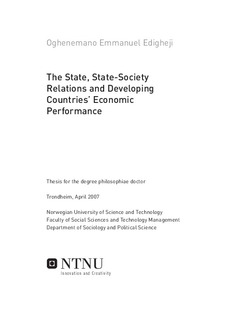| dc.description.abstract | Developing countries have undergone different development trajectories beginning in the 1970s -- a period that coincided with the current form of globalisation. Most of these countries have experienced low economic growth, poverty, high unemployment, diseases and inequalities. Few others have witnessed an unprecedented high rate of economic growth combined with qualitative improvements in the living standards of their people.
The initial and pervasive discourse about these diverse developmental outcomes was cast in terms of the former set of countries having gotten the “economic fundamentals” wrong while the latter set of countries got the “basic economic fundamentals” right. A key thrust of this conceptual framework was that the market is the most efficient allocator of resources and that integration into the global economy depends on the ability of countries to get the fundamental rights. Once again, there seems to be a resurgence of the Smithian invisible hand, where markets were seen as the best protector of the public good. Within this framework, the state becomes almost irrelevant to the process of national economic reforms and integration into the global economy – indeed unimportant to successful economic transformation and public welfare.
By the 1980s however, a school of revisionist institutionalists had emerged to reassert the centrality of the state to economic transformation. Broadly, this school argued that the ability of countries to take advantage of the opportunities flowing from economic globalisation depends on the state’s capacity. Consequently, a number of state capacity theories were advanced to explain variations in national economic outcomes among developing countries. Despite these various attempts, we lack a comprehensive state-capacity theory. Furthermore, most of these explanations relied on a hodgepodge of case studies, and few were comparative in nature. Although, these sorts of case studies are valuable for their mastery of details, most failed to operationalise how differences in state institutions lead to variations in national economic outcomes. The only existing study that has attempted to develop comparative indicators is limited to “Weberianness”, and by so doing excludes an important aspect of state autonomy. Worse, none of the studies provided measurable indicators for state-society relations as important domestic institutions. The discussion in this study is anchored in measurable indicators of state autonomy and (statesociety) synergy across developing countries. Furthermore, the study focuses on equitable growth rather than a narrower concern with growth that has been the major preoccupation of most studies.
This study develops a number of operational indicators for state institutions and state-society relations for the purposes of comparing developmental outcomes across countries. It develops and compares the institutional characteristics of twelve developing countries. On this basis, two main hypotheses were tested in this study, namely (a) that successful economic performance (that is high economic growth combined with low inequality) is highly associated with autonomous state institutions that are synergistically tied to its socio-economic partners, and (b) that a country’s institutional attributes determine its capacity to effectively engage with the globalisation process.
Through the pursuit and application of comparative indicators, the dissertation concludes that, indeed, countries with highly synergistic autonomous (Auto-Synergy) institutions have achieved egalitarianism and high economic growth. But contrary to a priori expectations, it also concludes that in rare circumstances, such as in countries with rich natural resource endowments and initial income and wealth distributions that altered the ownership pattern and production relations, countries with low or no levels of Auto-Synergy can still achieve equitable growth. | nb_NO |
